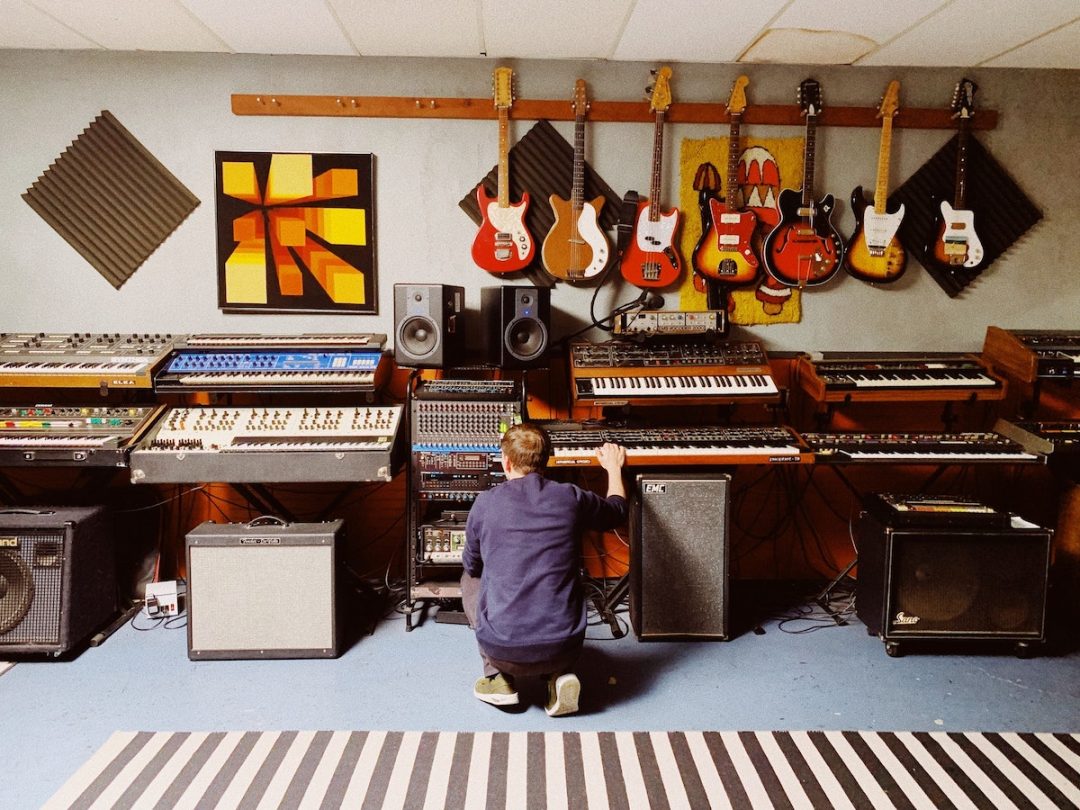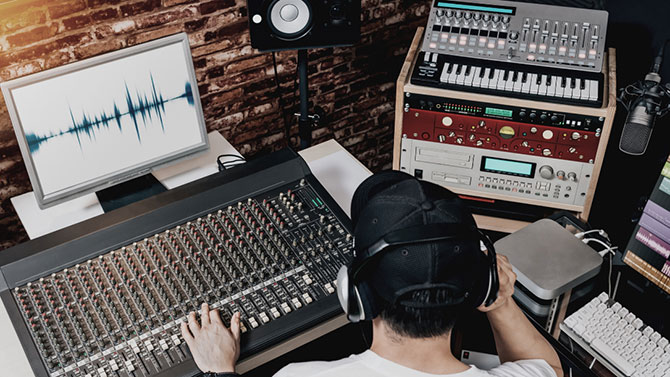To make a digital synth sound analog, use low-pass filters and add noise to mimic analog circuitry. By using this method, the digital synth can produce a warmer and more natural sound.
Digital synthesizers have overtaken analog synthesizers in recent years due to their affordability and versatility, but the warm, expressive, and unpredictable sound that analog synths create is still a highly sought-after quality among musicians and producers. While digital synths can produce a similar sound to analog, there are still notable differences in the way the sound is generated.
That’s why many musicians and producers choose to emulate the analog sound through digital synthesis. We’ll discuss how to make a digital synth sound analog by utilizing techniques such as low-pass filters and noise generation.
Understanding Analog And Digital Synths
Analog and digital synthesizers are both used to create electronic music, but there are significant differences between the two in terms of sound and functionality. Understanding these differences is the first step in learning how to make a digital synth sound analog.
Differences Between The Two Synths
Analog synths use voltage-controlled oscillators and filters to create sound waves. These waves create a warm, rich, and textured sound that is difficult to replicate digitally. In contrast, digital synths use algorithms and samples to generate sound, which can be manipulated more precisely.
Another key difference is that analog synths are often built with physical knobs and controls that allow the user to modify the sound in real-time. Digital synths, on the other hand, often use a computer interface for control, which can take some getting used to.
Advantages And Disadvantages
| Analog Synths | Digital Synths |
|---|---|
| Warm, organic soundReal-time controlUnique personality | Precise controlSample-based sound librariesCost-effective |
| ExpensiveCan be bulky and difficult to transportMaintenance required | Less personalityCan be difficult to programUninspired presets |
Ultimately, the choice between analog and digital synths comes down to personal preference and the specific needs of the user. For example, if you’re looking for a warm, vintage sound, an analog synth may be the best option. On the other hand, if you need precise control over your sound and want access to a wide range of preset sounds, a digital synth may be the better choice.

Credit: producelikeapro.com
Analog Signal Processing Techniques
When it comes to synthesizer sounds, most musicians are divided into analog and digital camps. Although digital synths are more common and accessible, many musicians still prefer the warmth and harmonic distortion of analog synths. Fortunately, with some “analog signal processing techniques,” you can make your digital synth sound like an analogue one. In this article, we’ll explore some analog signal processing techniques to get a more authentic sound from your digital synth.
Gain Staging Techniques
Gain staging is essential to analog signal processing. Proper gain staging ensures that your signal is at the right level throughout the processing chain. In the analog world, this means ensuring that the signal is neither too low nor too high, which can result in unwanted distortion.
With digital synths, gain staging is equally critical. You should avoid setting the levels too high, as this can lead to digital clipping. Instead, aim for the sweet spot, where the signal is strong, but not overbearing. A general rule is to keep your digital synth signal between -12db and -6db. If you need to boost the signal after recording, you can use analog-style plugins to add warmth and saturation.
Analog Waveform Generation Methods
The waveform generated by a synthesizer is the foundation of any sound. While digital synthesizers produce waveform through mathematical algorithms, analog synthesizers generate the waveform through electrical circuits. The difference in waveform production explains the sonic differences between the two types of synthesizers.
To make your digital synth sound analog, incorporate analog waveform generation methods. One way to achieve authentic analog tones is by using sampled waveforms from vintage analog synths. You can also use additive synthesis to layer harmonic overtones onto your sound.
Conclusion
By applying analog signal processing techniques, you can make your digital synth sound warmer, fuller, and more organic. Use gain staging to set your signal levels correctly while incorporating analog waveform generation methods to achieve a more authentic sound. These tips will help you bridge the divide between analog and digital synthesis and enhance your music production skills.
Distortion And Saturation Effects
To create an analog effect on a digital synth, try applying distortion or saturation effects. This can enhance the warmth and richness of the sound, giving it a more organic and realistic feel. Adjust the amount of distortion or saturation to achieve the desired effect.
Using Distortion To Emulate Analog Sound
To make a digital synth sound analog, introducing distortion can go a long way. Distortion can add warmth and grit to your sound, which is characteristic of analog instruments. It can mimic the effect of overdriving an analog circuit, resulting in a more organic and authentic sound. One way to achieve this is by using a distortion pedal, something that guitarists use. You can also use distortion plugins, which are readily available in most DAWs.
Tape Saturation Effects On Digital Synths
Tape saturation promotes the addition of warmth, depth, and harmonics to the audio signal, much the same way analog equipment does. It can disguise harsh digital sounds with a naturally compressed, round, and fuzzy sound that vintage synths are so famous for. Saturation plugins can generate multiple layers of harmonic distortion, imitating the sound of analog tape. Take note that distortion is different from saturation, and it is possible to use both in conjunction to achieve the desired effect. In conclusion, using distortion and saturation effects can elevate the sound of your digital synth and give it a classic analog feel. By experimenting with various distortion and saturation plugins, you can achieve unique sounds and textures while still retaining the flexibility and convenience of digital synths.

Credit: www.fullcompass.com
Filtering Techniques For Analog Sound
When it comes to synthesizers, many musicians prefer the warm, organic sound of analog synths over their digital counterparts. While digital synths are capable of producing a vast array of sounds, it can be difficult to replicate the character and warmth that analog synths are known for. However, there are techniques that can be used to make a digital synth sound more like an analog synth, and one important technique is filtering.
Low Pass Filter Importance
One of the key features of analog synths is their use of filters, particularly low pass filters. Low pass filters allow frequencies below a certain cutoff point to pass through, while attenuating frequencies above that cutoff point. This creates a warm, rounded sound that is often associated with analog synths. One way to replicate this sound in a digital synth is to use a low pass filter.
Digital synths often come with a range of filter types, including low pass filters. By adjusting the cutoff frequency and resonance of the filter, you can shape the sound to create a warm, analog-like tone. Experimenting with different filter settings can yield a range of unique sounds, so don’t be afraid to play around and see what works best for your music.
Emulating Filter Resonance In Digital Synths
Another important feature of analog synths is the use of filter resonance. Resonance refers to the boost in amplitude of a narrow band of frequencies around the cutoff point. This creates a distinct sound that is often described as “squelchy” or “nasal”. While it can be difficult to fully replicate true analog resonance in a digital synth, there are techniques that can come close.
One technique is to use a filter envelope to modulate the cutoff frequency of the filter. By adjusting the envelope parameters, you can create a sound that emulates the resonance of an analog filter. Another technique is to use a filter drive or distortion effect to add harmonic content and saturation to the sound. This can help to make the sound more grittier and more analog-like.
By utilizing these filtering techniques, you can make your digital synth sound more like an analog synth. With some experimentation and creativity, you can create warm, organic sounds that are reminiscent of the classic analog synths of the past.
Analog Envelope Techniques For Digital Synths
Transforming the sound of digital synths to replicate that of analog is highly sought after by many music producers. By using analog envelope techniques, such as using filters and modulating parameters, you can add warmth and depth to your digital synth sounds and create a more natural and organic sound.
Understanding Envelope Generators In Analog Synths
Analog envelope generators are responsible for shaping the sound generated by an analog synth. The four stages of the envelope – attack, decay, sustain, and release – determine how the sound changes over time. These stages can be adjusted to create a wide range of sounds, from percussive stabs to sustained chords. In an analog synth, the envelope generator is typically a dedicated circuit that controls the voltage level of the synth’s amplifier and filter over time.
Applying Envelope Techniques In A Daw
While digital synths often lack dedicated envelope circuits, many DAWs come equipped with virtual analog synths that offer a range of envelope controls. Applying envelope techniques in a DAW involves using these controls to shape the sound of a digital synth in a way that emulates the characteristics of an analog synth. By adjusting the attack, decay, sustain, and release controls, it’s possible to create sounds that closely resemble those produced by an analog synth.
Envelope Techniques For Achieving Analog Sounds
To achieve a more authentic analog sound in a digital synth, there are a number of techniques that can be employed. First, experiment with longer attack and release times to create a smoother, more gradual sound. Second, try adjusting the pitch and level of the oscillator to mimic the natural instability of an analog oscillator. Finally, consider adding subtle noise, distortion, or saturation to the signal to add warmth and character. By using these techniques in combination with careful envelope shaping, it’s possible to create digital synth sounds that are virtually indistinguishable from their analog counterparts.

Credit: blog.native-instruments.com
Frequently Asked Questions For How To Make A Digital Synth Sound Analog
How Do You Make A Digital Instrument Sound Analog?
To make a digital instrument sound analog, you can use plugins or hardware equipment that emulate analog sounds. Certain processing techniques like saturation, distortion, and compression are also used to add analog warmth and character to digital sounds. Additionally, using analog gear like tape machines and analog synths can also help achieve an analog sound.
What Makes A Synth Analog?
An analog synthesizer uses analog circuits to generate and manipulate sound, whereas a digital synthesizer uses a microprocessor.
Do Analog Synths Sound Better Than Digital?
Analog synths have a warmer, richer, more organic sound compared to digital synths. However, digital synths have better sound editing capabilities, more features like presets, and are easier to use. It ultimately depends on personal preference and the specific sound you’re going for.
How Do You Make A Song Sound Analog?
To make a song sound analog, use analog gear like vintage microphones, tape machines, and analog synthesizers. Record live instruments to capture the warmth of acoustic sound. Avoid digital plug-ins that sound too clean and sterile, and add some tape hiss, distortion, or flutter to give the impression of analog tape.
Use mono recordings or panned stereo to achieve a vintage sound.
Conclusion
To summarize, making a digital synth sound like an analog one is not an impossible task. By using the right techniques, such as adding noise, distortion, and modulation effects, you can achieve warm and vintage sounds that many musicians desire.
While analog synths may have a certain charm, digital synths have their advantages as well, such as affordability and convenience. But with these tips in mind, you can get the best of both worlds and create stunning tracks that stand out.
Experiment and have fun!